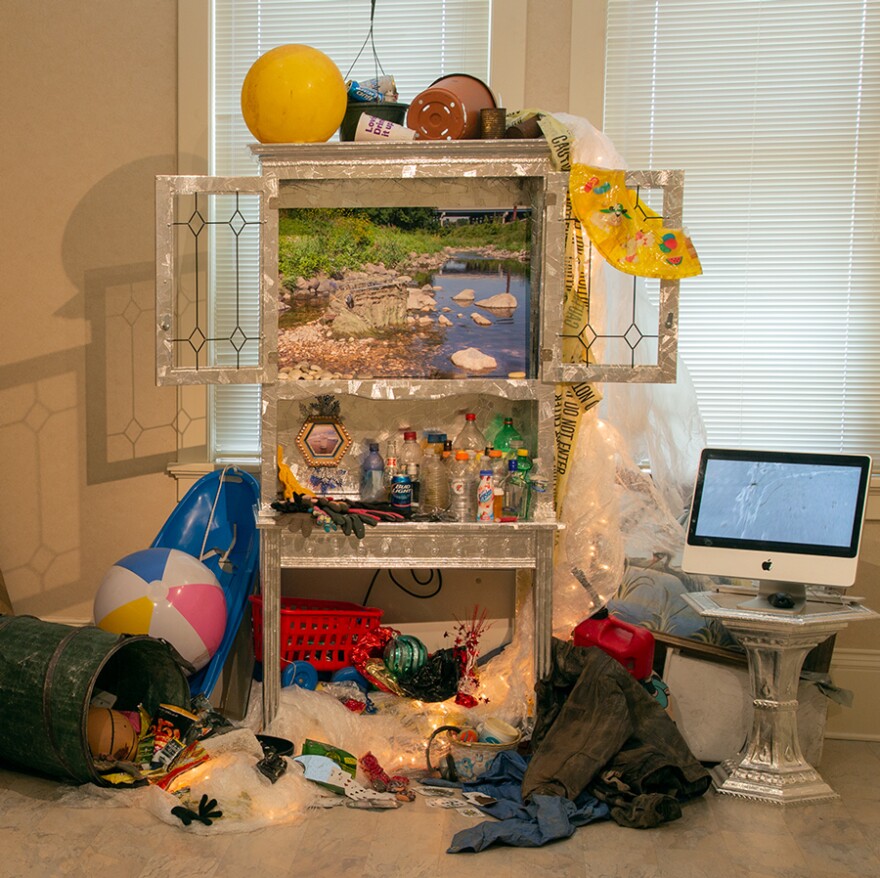Issues facing the natural world have inspired Melanie Ariens' 30-year career. For the last decade or so, the Milwaukee artist's work has been all about water, in particular the Great Lakes.
Ariens' work was recognized Tuesday in Washington, D.C. by a national advocacy group called River Network. She is the first artist to receive this honor.
Before heading to D.C., Ariens stood on the deck of her Whitefish Bay bungalow, sorting through plastic supply bins labeled "shrine" containing different little elements. She's been creating them for years. Ariens' first shrine, which featured her signature Great Lakes map, served as inspiration.

Over the years, Ariens has installed shrines in unexpected places — some as large as 7.5 feet tall, some plunked in the Milwaukee River or along the city's Riverwalk.
"Because we don't honor water the way we should. We take it for granted, and boy, what if we didn't have that? Some places in the world, they don't have [water]," she says.
Ariens wants to inspire people of all ages to get to know their watershed, their impact on it and the importance of stewarding it.
Everyone can be a water leader, but the artist, who naturally wears a smile on her face, finds people are inspired by funky, bejeweled shrines rather than being lectured. "I try to use a little joy and happiness in my work to get people thinking about tough water issues."
Ariens latest shrine features a water glass, fabric, lights and photos needed to fit into a suitcase. She would be installing it in Washington D.C. at the annual gathering of the River Network. Ariens is one of five people from around the country being recognized for their work to protect and restore local waters. The award has been around for more than 20 years.
"I'm happy to be the first artist receiving the award," Ariens adds with a smile, "hopefully I won't be the last."

Ariens' shrine creations have proven to be a central element as the local advocacy group Milwaukee Water Commons came to life, starting in 2014 when people from four Milwaukee neighborhoods gathered in a church basement.
Ariens showed the group the shrine that adorns her studio for inspiration and then pulled out Altoid tins and all manner of glittery supplies. The mini water shrine makers became the conduits to encourage more neighbors to engage in water issues.
Ariens is now Milwaukee Water Commons artist in residence.
Another Ariens' inspired project introduced 10- to 13-year-olds to water stewardship. The goal was to reduce the kids' use of throw-away water bottles in a fun, creative way.
The students painted and then cut hundreds of bottles into delicate tendrils that became a big art piece inspired by a famous glass artist. "A big Dale Chihuly-style inspired sculpture," Ariens explains.
Students then got to decorate their own reusable water bottles. "They used colored duct tape, glittery letters to put their name on it and some images of the Great Lakes. It was a great time for us to have a conversation about why we use refillable bottles."

There seems to be no end to Ariens' inspiration to celebrate and highlight concerns around water through art and sometimes the artist's call for action has been less subtle.
For example in a 2019 project that focused on plastic water bottle waste where Ariens worked with more than 400 students, Ariens called for changes within the school. "When they asked me to do this project, I asked the school, 'What do you serve water in when you have meetings?' And it was bottled water. And I actually told them I wouldn't work on this project unless they started making changes at the school."
And the school made the changes. "They made a campaign to use reusable water bottles and pitchers and glasses at meetings," she says.
With Ariens' guidance, the students created a massive installation called 1,500 bottles a second, which is the rate of plastic bottle disposal in the U.S. The resulting 10-foot sculpture is a giant water bottle fashioned of recycled barrels and pallet wrap, from which "water" made of 1,500 water bottles pours.
"The students did most of the work and I just designed it so it would be structurally sound and it traveled to eight places in Milwaukee and now it lives down at Discovery World," she says.

Ariens wishes she could have shared one of her trademark creations with those gathering in D.C., a 7 ½ by 12-foot piece titled Tattered. Ariens sewed strips of beat up jeans
she then snapped together to create the basin.
"We're hard on our freshwater sometimes. Some of our ecosystems are beat up," Ariens says. "It's a point even people dedicated to clean sustainable water need to be reminded of."
You can bet the water hero will return to her hometown with more ideas on ways to get people to think about water issues while being charmed and sometimes amazed.

Have an environmental question you'd like WUWM's Susan Bence to investigate? Submit below.
_






